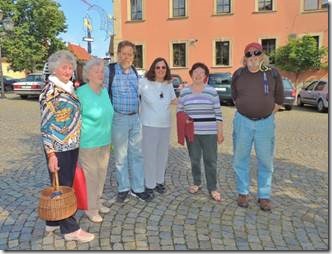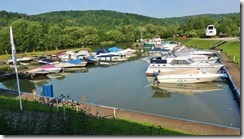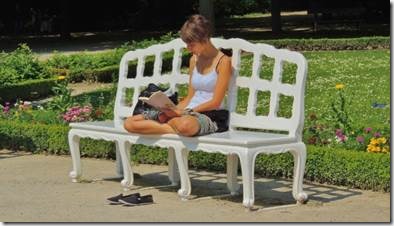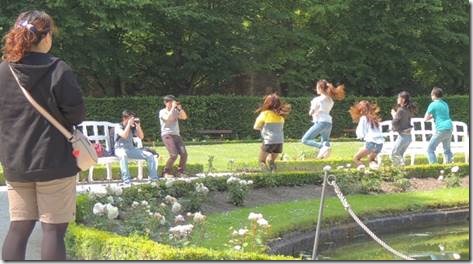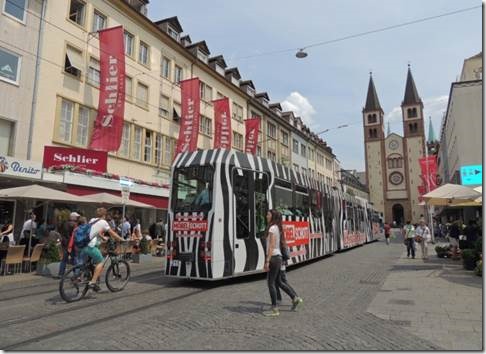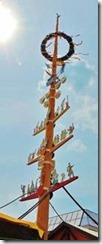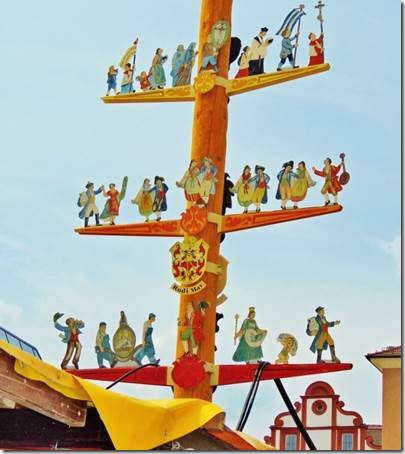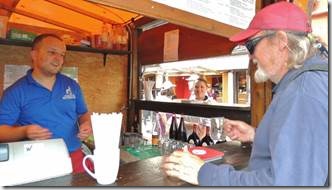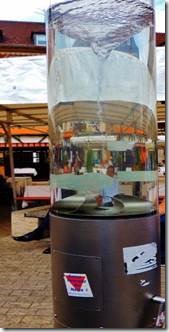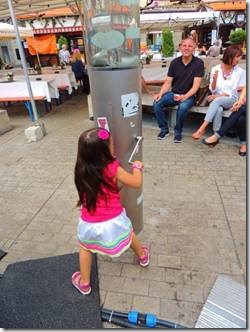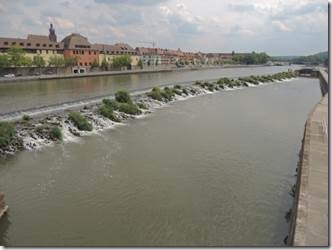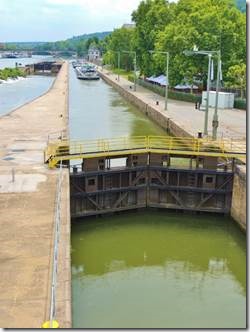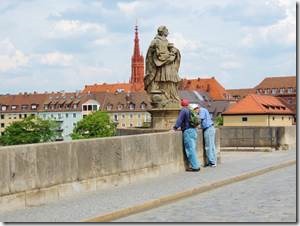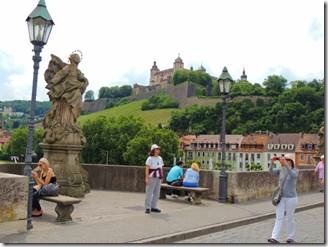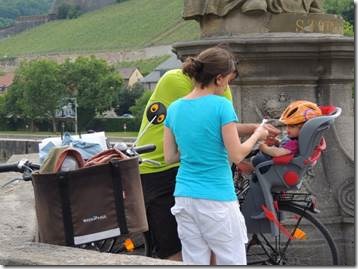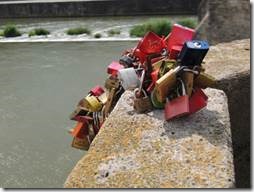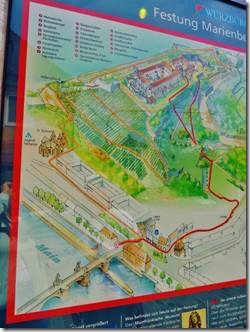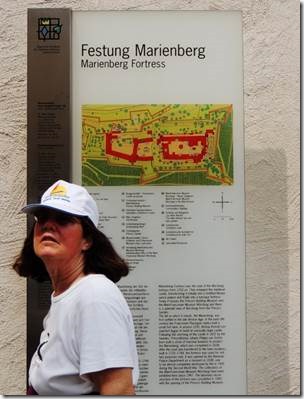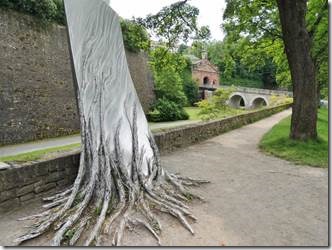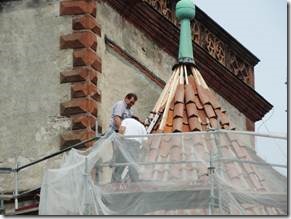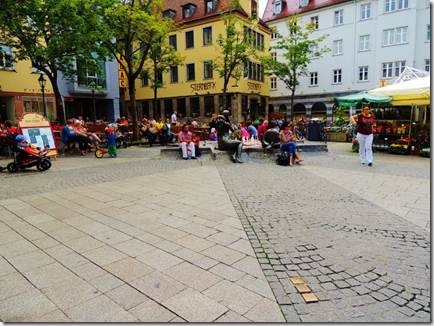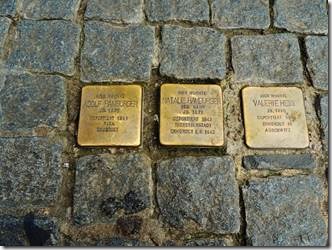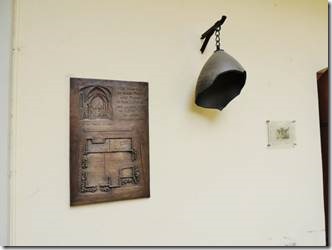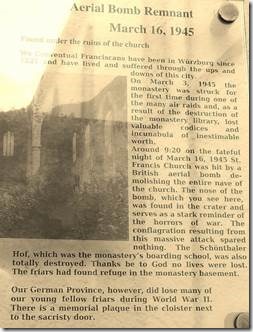Charly and Erika’s marina near Bamberg
Guten Morgen,
Today we’re headed for a quick visit to Bamberg. I say quick because we really only spend several hours most places we visit and that’s just enough time for a quick walk through. And lunch and coffee and probably ice cream later as now it’s quite hot here; the temps in the low 90s!
Charly and Erika are the most welcoming people and we feel more at “summer camp” than just a yacht club. We went cherry picking with Erika and a local barbeque fund raiser.
This email is about our quick tour of Wurzburg.
Ru
The first fortifications on the hill where the Marienberg Fortress now stands date from a thousand years before Christ, when the Celts built one of their formidable ring fortresses on this prime defensive position.
The city itself grew in the 7th century as it became the seat of a Franconian lord and, eventually, a religious centre and a place of pilgrimage for the martyred St Kilian.
In the 12th century the first of the powerful bishops was elevated to the worldly rank of Prince Bishop (actually "Duke of Western Franconia") – an important step as that meant that church donations and tithes as well as regional taxes all flowed into the bishops’ administration.
Würzburg had grown so powerful that it was considered the unofficial capital of the Holy Roman Empire – the wedding of Emperor Frederick I was held here, for example.
The fortress on the Marienberg was important to the Prince Bishops not only for its prominence but also for its defensive qualities. The citizens of Würzburg, possibly fed up with the taxes, declared themselves for the peasants’ side in the Peasants’ War of the 16th century.
Through various wars and fires, both the city and the fortress were continually expanded and provided with stronger defences. In the 18th century, the age of absolute rulers who brought a relative stability to the lands the controlled, the Prince Bishops felt secure – and rich – enough to build themselves a palace befitting their position in the city down below. The Residence was finished at the end of 1744.
Eventually the Napoleonic Wars caused the downfall of the Prince Bishops and the city passed under the control of Bavaria.
The city suffered appalling damage at the end of the Second World War. Although filled with refugees and injured (it was considered a "hospital city") a massive bombing raid was carried out on the city on March 16, 1945. Within 17 minutes 87% of the city was destroyed in a massive firestorm which could be seen from over 230km away.
The city became known as the "Grab am Main" ("the grave on the River Main") and the subsequent American occupation even put forwards proposals to build a new city in another location and to keep the ruins as a memorial (proposals which were heartily rejected by the remaining population who concentrated in the post-war decades on the reconstruction of the Würzburg of their memories).
http://www.romanticroadgermany.com/wuerzburg/index.php
|
A welcoming committee in Eibelstadt where we parked the boat overnight We were the second largest boat to ever come into this yacht club. Not many “live aboard” pleasure boats make this journey. The small, plentiful, yacht clubs along the way are designed for smaller boats and the cruise ships stop at public docks built for them. Our size boat is the “odd man out.” That’s why we didn’t stop in Wurzburg with the boat; no place to park. But Eibelstadt was lovely and the club manager very helpful. We took the bus to Wurzburg for the day. |
|
Our first stop was “the Residence.” But no photos allowed inside. Another book reader. Yī’ èr sān One, two, three…jump! Outside the 18th century Bishops Residence where everyone was enjoying the gardens in his or her own way. No photos were allowed in the Residence which was huge and ostentatious to befit the times. http://www.hofgarten-wuerzburg.de/englisch/virtual/index.htm is a virtual tour. |
|
Zebra “electric train” heading towards the Dom “The Cathedral is dedicated to the Irish martyr St Kilian, who met his death here on missionary work. The original cathedral is now thought to have been where the current Neumünster basilica is located – the location of the current cathedral was chosen in the 11th century. The cathedral was badly damaged in aerial bombing that destroyed much of Würzburg at the end of the Second World War. In 1946 much of the remaining building collapsed and reconstruction lasted until the 1960s. The Neumünster was where the bones of St Kilian and his two assistants were said to have been "rediscovered" (they had been killed for trying to persuade the current ruler that his marriage was "unchristian"). During the time of the closure of the cathedral it served as a replacement and is now officially the Würzburg parish church.” |
|
A ‘May Pole’ had been erected in the town center; I can’t remember having ever seen one before. 1st May is maypole day in Bavaria and a day for the local folklore group dressed in their finest costumes to gather all the villagers together to celebrate this important annual occasion. Each and every maypole is uniquely decorated with ribbons, wreaths or signs denoting local craftsmen’s guilds. Soon it is time for the brass band to tune up and accompany the dancers well into the night. A traditional dark “Maibock“ beer is brewed especially for the occasion. The hoisting of a maypole is an important part of all spring festivities. Most Bavarian villages have a club known as the “Burschenverein” that is akin to Young Farmer’s associations. Long before the 1st May the young men of the Burschenverein go out to the woods to choose a tall straight pine tree that is then felled and hidden away for safe keeping. The earliest reports of Maypoles, as a symbol of all things that grow and bear fruit, date back to the 13th century. Today the Maypole reflects the wealth of the paticular community. Part of this whole tradition is that one village tries to steal the maypole from the neighbours. If they succeed the safe return of the maypole is up for negotiation with ransoms involving copious quantities of beer and food. Some "Burschenvereine" have specialised in stealing the maypoles that are most closely watched by the strongest security. Maypole stealing is governed by a pretty strict code of conduct: sawing or damaging the maypole in any way is absolutely frowned upon as is a non-payment of the ransom. The most spectacular theft occurred back in 2004 when cunning thieves stole the maypole from the top of the Zugspitze using a helicopter. Once the 20 m long maypole had been safely flown to an Alpine hut negotiations began to determine how much ransom would be paid for its return. Rumour has it that the there were copious quantities of food and the beer flowed freely all night. Hoisting the maypole is a really tough job that makes most men break out in a sweat. It is raised using smaller trees that have been stripped of the bark and slung together at the top by thick rope together with a whole lot of muscle power. Centimetre by centimetre the maypole is slowly hoisted into a pre-prepared hole. Once firmly anchored in place it is decorated with signs indicating local craftsmen’s guilds and topped with a wreath from which sausages, bacon, wine and schnapps bottles are hung. Fixing the wreath in place is the job of the "Maibaumkraxler" who has to scale the maypole, attach the wreath and make it safely back down to the ground again. When all the work is done its time to celebrate with Bavarian brass band music and dancing long into the night. |
|
This part of Germany is grape growing country so wine making country so wine drinking country. Every town is having a wine festival now so we joined in at Wurzburg’s. There was a 2 Euro deposit for each wine mug which you could keep or return for your deposit. We turned ours in. |
|
I saw some young teenaged boys cranking the arm of this contraption to make a cyclone. So, of course I had to try. Then this little girl who had seen me, she had to try. She did quite well too. |
|
We had to ‘lock through’ the Schleuse Randersacker in Wurzburg to get to Eibelstadt. |
|
“Würzburg’s Old Main Bridge (Alte Mainbrücke) was built 1473–1543 to replace the destroyed Romanesque bridge that had dated from 1133. In two phases, beginning in 1730, the bridge was adorned with statues of saints and historically relevant figures. The bridge shows similarities to the Charles Bridge in Prague.” Wikipedia In the background is the Marienberg Fortress our destination after crossing the bridge from Wurzburg Center “The Fortress Marienberg is visible from seemingly everywhere in Würzburg. Originally, there was a celtic palisade castle at this site. 704 AD the first Würzburg church was erected here. At the beginning of the 13th century fortificatins were built around the church. The Fortress was expanded and renovated several times during the renaissance and baroque periods.” |
|
Stopping on the bridge to share some ice cream and a bundle of ‘love locks’ |
|
The map showing the route from the bridge to the fortress and a map of the fortress. |
|
The tree trunk sculpture at the entrance and men working to repair the mansard roof on one of the fortress buildings were what I found most interesting. The rest of the fortress not so much. The church entrance was blocked and you couldn’t climb the tower. Then it was back down the hill to town to catch the bus back to Eibelstadt. |
|
Stolperstein, or "stumbling stones" there are more than 30,000 commemorative bricks in dozens of cities and towns across Germany. http://www.npr.org/2012/05/31/153943491/stumbling-upon-miniature-memorials-to-nazi-victims "I think the large Holocaust memorial here [in Berlin] will always remain abstract. You have to make the decision to visit it," Demnig says. "But not with the stumbling blocks. Suddenly they are there, right outside your front door, at your feet, in front of you." I did stumble across these ‘stones’ not looking for them. But once you’ve seen any, in any city or town, you notice them, I stop to read the names. |
|
A reminder of war’s destruction. The bombing and destruction of the Francis Church which has been rebuilt. A fragment of the bomb is hanging here on the entrance wall. |

